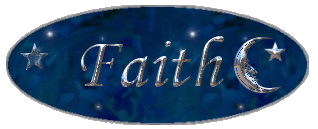
Home
Faith
Deities
Magik
Animals
Trees
Plants
Images
Stories
Message Board
Awards
Email
 |
 |
 |

The Belief
What is faith, and why is is a part of the Nemeton, a unique part of the web that ties together the mysteries of life that exist here?
Simply, because faith is a part of life. All life. There is noone who exists who believes in nothing regardless of what they may tell you.
Faith is not only belief in a greater essence or a higher good. It is, or can be nothing more than a belief in tomorrow, belief in another person, or the world around us, or the good in life or mankind, or simply the faith in their own ability to do well, or remain well in any given situation.
Faith sustains us in our journey through that life.
Faith in life, in the turning of the tides, the changing of seasons, the celebration of that life, and understanding of the death and rebirth, comprises the faith of the Pagan,.
A simple silent belief in the circle that was and is the endless walk of life.
Faith in birth, life, death, and rebirth are a part of who we are.
The continuity of life is shown in the way in which summer gives way to autumn, winter again brings forth life beneath the snows, a rebirth of life.
God and Goddess represent the divine forces of life, as well as the elemental forces of nature, which is life itself.
We may conclude from this, that the worship, the belief, is, and should be, more than simply in Lord and Lady, but is the worship and belief in life itself, in the endless chain of nature, and our own presence there, and more, an understanding of our place within that chain.
There are those who see humanity as the forger of the links.
The Christian Bible affords this directive to its members in the book of Genesis:"fill the Earth and subdue it".
Paganism differs from Christianity markedly in one single way.
Those of us who practice Paganism, Celticism, Native American faiths, see clearly that we do not forge the links, but are one of them, a link in the chain that is life.
We may not subdue the Earth, but rather, must become attuned to it, a part of its changing, growing, living whole.
Clearly, given the advantages of humanity however, we owe a greater debt to those who forged the chain, hold more responsibility for assuring the continuation of the other links which bind it delicately together.
What We Celebrate Our religious year revolves endlessly around the changing seasons, what we term the wheel of the year.
It is a celebration of the endless wheel of life, the seasons, and the movements of the sun and moon.
Sabbats
There are eight Great Days, or Sabbats, which are representative of the turning wheel.
They are divided into two seasons, primarily summer and winter.
- Yule or Winter Solstice
Celebrates the birth and return of the Sun Child, the lengthening days, and a hope of regreening. - Imbolc or Brigids Fire
honors the Goddess Bride, patroness of hearth and home, the sanctuary of the sacred fire. - Ostara, or Herthas Day
Also concides with Spring Equinox, celebrating the return of spring, the greening of nature, the rebirth of the sun - Beltane
celebrated on May eve. It is a fire festival, to honor the God Bel, new life and the coming summer. - Midsummer or Litha
the longest day of the year, celebrating the beginning of shorter days, the slow death of the sun, and Lugh, who rules the darker side of the year. - Lughnassad or Lammas
The first harvest, celebrating the union of light and darkness, summers end, a time of gathering and replenishing stores. - Mabon or Autumn Equinox
The last harvests, the dying sun, a time of gathering of seeds for next springs planting. - Samhain
meaning literally, the end of summer, the time of death. The veils between time and space are thinnest now, and feasts are held for those who have passed before us.
How We Celebrate
Ritual Celebrations are held with the circle usually held outdoors, although it has to us the sanctity that Christians associate with their church sanctuary.
Each Holy Day, or Sabbat, has specific rite, or celebration that is associated with it. Most often these are somehow associated with the specific time of the year, what is being celebrated, or the place on the wheel if you will.
- Yule
is often celebrated with the evergreen tree, a symbol of life unending, with decorations of greenery, with a creche, as a symbol of the rebirth of the sun, or with candles or lights, which again are representative of the hope of the coming light. - Imbolc, Brigids Fire, Candlemas
are a few of the names given to this celebration of the coming light.
Bride's temple is the home of the sacred fires, representing this, the High Priestess lights a fire kindled of nine sacred woods. Seeds are planted indoors, candles are burnt, and the sacred fire of the sun honored. - Ostara
Celebratory of the springs coming, sees the planting of seeds indoors, the purification of homes through cleaning, the eggs colored as symbols of fertility, and the rabbit celebrated as baby rabbits are born in this time. - Beltane
Traditionally a fire is lit using sacred means, often jumped over, maypoles are erected as symbols of life, and rites of purification are carried out. - Litha
Blessing the water, and using it to nourish the plants of Ostara, decorating the door with birch, roses, or making bird feeders for the coming dark times, are some of the ways we can celebrate Litha.
- Lughnassad
Traditionally the destruction of the corn mother is held at this time. The last corn sheaf is drenched with water and kept as a symbol of the Goddess blessings and the abundance of the harvest. - Mabon
Feasting, stories and music are traditional celebratory means for Mabon. The final harvest time, when the seeds are gathered and stored for next years planting. - Samhain
As the veils are thinnest, this is a time for communication with Otherworld. Contact with deities is also easier at this time of the year, feasts held in honor of, or for the departed, with the food remaining left outdoors in the arms of the Earth, for any who would take.
|
|
|



